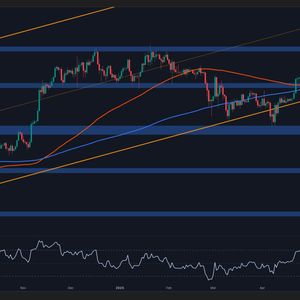Urgent Crypto Tax Ukraine: Shocking 23% Levy Proposed Amidst War
5 min read
Hold onto your hats, crypto enthusiasts! Just when you thought the global crypto landscape couldn’t get any more interesting, news breaks from Eastern Europe that’s sending ripples through the digital asset world. Ukraine, a nation already navigating unprecedented challenges, is now proposing a significant overhaul of its crypto taxation framework. And it’s not just a tweak; we’re talking about a potentially shocking 23% combined tax levy on cryptocurrency gains. Let’s dive deep into what this means for crypto users in Ukraine and the broader implications for digital asset taxation globally. What’s the Latest Buzz Around Crypto Tax Ukraine? According to recent reports from Crypto News, the National Securities and Stock Market Commission (NSSMC) in Ukraine, headed by Ruslan Magomedov, has put forward a proposal that could fundamentally change how cryptocurrencies are taxed in the country. The core of the proposal? An 18% income tax coupled with an additional 5% defense levy on profits derived from cryptocurrency activities. This move is being framed as part of Ukraine’s ongoing efforts to formalize the digital asset sector, especially crucial during the current wartime scenario. But what exactly does this entail, and why is Ukraine taking this step now? Why is Ukraine Proposing Stricter Crypto Regulation and Crypto Income Tax Now? Several factors are likely contributing to Ukraine’s push for enhanced crypto regulation and the introduction of a substantial crypto income tax . Let’s break down the key reasons: Wartime Economic Needs: First and foremost, Ukraine is currently engaged in a conflict that demands significant financial resources. The 5% defense levy is explicitly intended to bolster the nation’s defense capabilities. In times of war, governments often seek to maximize revenue streams, and the burgeoning crypto market presents a relatively untapped area for taxation. Formalizing the Digital Asset Space: Beyond immediate financial needs, there’s a broader global trend towards bringing the crypto market under regulatory frameworks. Governments worldwide are grappling with how to tax and oversee digital assets. Ukraine’s proposal can be seen as aligning with this global movement to formalize the digital asset taxation landscape. Revenue Generation: Even outside of wartime, governments are always looking for ways to increase tax revenue. As cryptocurrency adoption grows, taxing crypto gains becomes an increasingly attractive option. An 18% income tax on crypto profits could represent a significant new revenue stream for the Ukrainian government. Transparency and Control: Regulation brings transparency. By implementing a clear tax framework, Ukraine aims to gain better visibility and control over cryptocurrency transactions within its borders. This can help in combating illicit activities and ensuring fair financial practices. Decoding the Proposed 18% Crypto Income Tax and 5% Defense Levy Let’s break down the numbers and understand what this 23% combined levy could mean in practical terms. Tax Component Percentage Purpose Income Tax 18% General government revenue Defense Levy 5% Funding national defense efforts during wartime Total Crypto Tax 23% Combined tax on cryptocurrency gains Imagine a Ukrainian crypto investor who makes a profit of $10,000 from trading Bitcoin or Ethereum. Under this proposal, they would be liable to pay $1,800 as income tax and an additional $500 as a defense levy, totaling $2,300 in taxes. This is a substantial amount and could significantly impact the profitability of crypto investments in Ukraine. What are the Potential Benefits and Challenges of Ukraine’s Defense Levy Crypto Tax? Like any significant policy change, Ukraine’s proposed crypto tax framework comes with its own set of potential benefits and challenges. Potential Benefits: Increased Government Revenue: The most immediate benefit is a potential boost to government coffers. The combined 23% tax could generate significant funds, particularly the 5% defense levy crypto tax, which is directly aimed at supporting national defense during a critical time. Formalization of Crypto Market: Clear tax rules can bring legitimacy and structure to the Ukrainian crypto market. This could attract more traditional investors and businesses who prefer operating within a regulated environment. International Alignment: By implementing crypto taxes, Ukraine aligns itself with global trends in digital asset regulation, potentially improving its standing with international financial bodies and partners. Potential Challenges: Impact on Crypto Adoption: A high tax rate could deter crypto adoption in Ukraine. Investors might be less inclined to engage with cryptocurrencies if a significant portion of their profits is taxed. This could stifle innovation and growth in the domestic crypto sector. Enforcement Difficulties: Taxing crypto is inherently complex. Tracking transactions across decentralized networks and ensuring compliance can be challenging, even with the best regulatory framework. Effective enforcement will be crucial for the success of this proposal. Competitive Disadvantage: If neighboring countries or other crypto-friendly nations have lower or no crypto taxes, Ukraine could become less attractive for crypto businesses and investors. This could lead to capital flight and hinder the growth of Ukraine’s digital economy. Complexity and Compliance Burden: Navigating a new tax system, especially one involving digital assets, can be complex for individuals and businesses. Clear guidelines, educational resources, and streamlined compliance processes will be essential to minimize the burden on taxpayers. Actionable Insights: What Does This Mean for Crypto Users? If you are a crypto user in Ukraine or are considering investing in the Ukrainian crypto market, here are some actionable insights: Stay Informed: Keep a close watch on the developments surrounding this proposal. Regulations can evolve, and the final implementation might differ from the initial proposal. Follow reputable crypto news sources and official government announcements. Seek Professional Advice: Consult with tax advisors who specialize in cryptocurrency taxation. Understanding your tax obligations under the new framework is crucial for compliance and financial planning. Plan Your Investments Strategically: Factor in the 23% tax when evaluating the potential profitability of your crypto investments in Ukraine. Consider how this tax rate might impact your overall investment strategy. Advocate for Fair Regulations: Engage with crypto advocacy groups and participate in discussions about crypto regulation in Ukraine. Your voice can contribute to shaping a balanced and effective regulatory framework. Conclusion: Navigating the New Crypto Tax Landscape in Ukraine Ukraine’s proposal to impose an 18% income tax and a 5% defense levy on cryptocurrency gains marks a significant moment in the country’s approach to digital asset taxation . While the move aims to boost government revenue and formalize the crypto sector, it also presents potential challenges for crypto adoption and competitiveness. The coming months will be crucial in observing how this proposal evolves and how effectively it is implemented. For crypto users and stakeholders, staying informed, seeking expert advice, and strategic planning will be paramount to navigating this new tax landscape in Ukraine. The global crypto community will be watching closely to see how this unfolds and what precedents it might set for other nations grappling with similar challenges. To learn more about the latest crypto market trends, explore our article on key developments shaping Bitcoin price action.

Source: Bitcoin World



